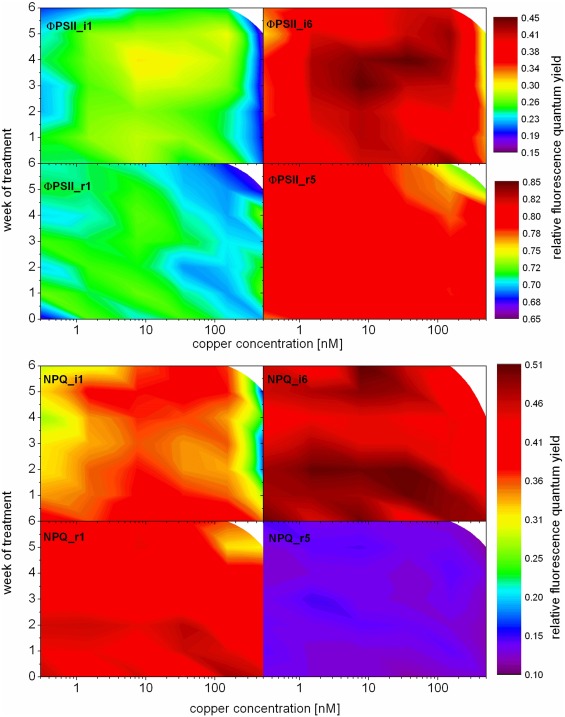 Essential trace elements (Cu2+, Zn2+, etc) lead to toxic effects above a certain threshold, which is a major environmental problem in many areas of the world. Here, environmentally relevant sub-micromolar concentrations of Cu2+ and simulations of natural light and temperature cycles were applied to the aquatic macrophyte Ceratophyllum demersum as a model for plant shoots. In this low irradiance study resembling non-summer conditions, growth was optimal in the range 7.5-35 nM Cu, while PSII activity (F-v/F-m,) was maximal around 7.5 nM Cu. Damage to the light harvesting complex of photosystem II (LHCII) was the first target of Cu toxicity (>50 nM Cu) where Cu replaced Mg in the LHCII-trimers. This was associated with a subsequent decrease of Chl a as well as heat dissipation (NPQ). The growth rate was decreased from the first week of Cu deficiency. Plastocyanin malfunction due to the lack of Cu that is needed for its active centre was the likely cause of diminished electron flow through PSII (Phi(PSII)). The pigment decrease added to the damage in the photosynthetic light reactions. These mechanisms ultimately resulted in decrease of starch and oxygen production.
Essential trace elements (Cu2+, Zn2+, etc) lead to toxic effects above a certain threshold, which is a major environmental problem in many areas of the world. Here, environmentally relevant sub-micromolar concentrations of Cu2+ and simulations of natural light and temperature cycles were applied to the aquatic macrophyte Ceratophyllum demersum as a model for plant shoots. In this low irradiance study resembling non-summer conditions, growth was optimal in the range 7.5-35 nM Cu, while PSII activity (F-v/F-m,) was maximal around 7.5 nM Cu. Damage to the light harvesting complex of photosystem II (LHCII) was the first target of Cu toxicity (>50 nM Cu) where Cu replaced Mg in the LHCII-trimers. This was associated with a subsequent decrease of Chl a as well as heat dissipation (NPQ). The growth rate was decreased from the first week of Cu deficiency. Plastocyanin malfunction due to the lack of Cu that is needed for its active centre was the likely cause of diminished electron flow through PSII (Phi(PSII)). The pigment decrease added to the damage in the photosynthetic light reactions. These mechanisms ultimately resulted in decrease of starch and oxygen production.
Keywords: biophysics of photosynthesis; cadmium detoxification; Ceratophyllum demersum; chlorophyll fluorescence kinetics; copper deficiency; environmentally relevant conditions; Gauss-peak spectra; harvesting complex II; induced inhibition; metalloproteomics; metal-substituted chlorophylls; photosynthetic electron-transport; physiological stress; superoxide-dismutase; thiol metanolism; water plants
